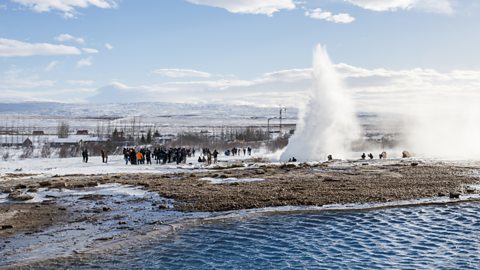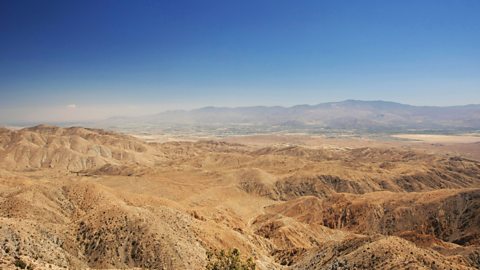Constructive plate boundaries
At a constructive plate boundary - also known as a divergent plate boundaryAn area where two tectonic plates are moving away from one another. - the plates are moving apart from one another. When this happens, the magma from the mantle rises up to make (or construct) a new crust. The movement of the plates over the mantle can cause earthquakes. Rising magma can also create shield volcanoA volcano with gentle slopes that was made by runny, less explosive basic lava..
Landforms associated with constructive plate boundaries
Large scale landforms at a constructive plate boundary include:
- ocean ridges - such as the Mid-Atlantic ridge, where the Eurasian plate and the North Atlantic plate are moving apart from each other under the Atlantic Ocean
- rift valleys - such as the East African Rift Valley where the African plate is tearing itself apart
- shield volcanoes
Small scale landforms at constructive plate boundaries are lava tubes and geysers.
| Large scale landforms (Constructive plate boundary) | Small scale landforms (Constructive plate boundary) |
| Shield volcanoes | Lava tubes |
| Rift Valley | Geysers |
| Large scale landforms (Constructive plate boundary) | Shield volcanoes |
|---|---|
| Small scale landforms (Constructive plate boundary) | Lava tubes |
| Large scale landforms (Constructive plate boundary) | Rift Valley |
|---|---|
| Small scale landforms (Constructive plate boundary) | Geysers |

Conservative plate boundaries
At a conservative plate boundaryAreas between two crustal plates that are moving past each other in opposite directions or at different speeds. , the plates slide past each other in opposite directions, or in the same direction but at different speeds. As the plates try and move, friction occurs and plates become stuck. Pressure builds up because the plates are still trying to move. When the pressure is released it sends out huge amounts of energy, causing an earthquake. The earthquakes at a conservative plate boundary can be very destructive as they occur close to the Earth's surface. There are no volcanoes at a conservative plate boundary.
A large scale landform found along a conservative plate boundary is a fault line. One of the most active fault lines in the world is the San Andreas fault line in California, USA.
